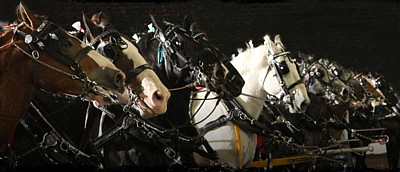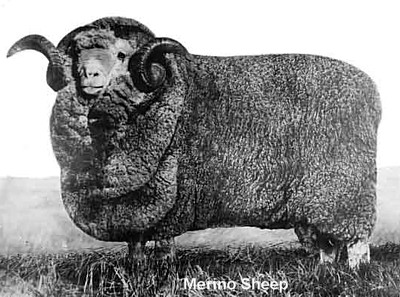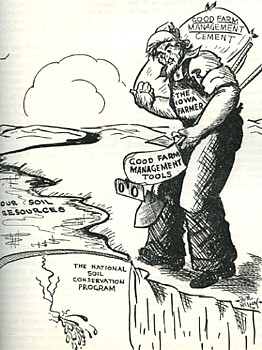|
RINGGOLD COUNTY IOWA HISTORY
CHAPTER FIVE ~ CHANGES THAT CAME WITH THE RAILROAD

NOTE: Transcribed as written at the time, some terms not considered to be politically correct at the present time.
When railroads were extended through Ringgold County,
stock raising became still more profitable. Long hauls by
wagon, or long drives to market, were no longer necessary.
Farm communities grew more compact, centering their trading
activities in nearby towns. Some of the railroad station
points had stockyards, and all of the villages made bids to
handle the stock shipments. Some of the rural churches
moved to town and more business sprang up.
Since 1876 the county had been known for its fine
horses. Thousands of thoroughbred Percherons, Normans, Clydesdales,
English Shires, and Belgians were shipped from nearly
every railroad station. In addition to draft horses, a few
sotckmen bred Cleveland bays and French coach horses. The
leading breeder of these roadsters was Melvin BENNETT, who
owned the fastest stallion in southwestern Iowa. During the
1880's and 1890's Ringgold County was known for its matched
teams as far away as Boston, Massachusetts, and the people
in the villages were as proud of the county's fine horses as
were the breeders themselves. One of the most successful
breeders was
E. N. [Elucaus Nelson] DeWITT, who, with his brothers, ran the
livery stable in Tingley. Some of the DeWITT stallions took
sweepstatke prizes at Illinois State and county fairs. The
DeWITTS frequently paid as high as $2,500 for breeding stock.
D. D. McGREGOR of Tingley had the reputation of raising the
best horses in the county. He bred draft horses and had
specimand in his stable that weighted from 1,800 to 2,300
pounds each.
Prominent horsemen in the county rated one particular
carload of horses shipped to the Boston, Massachusetts,
market in February 1885 as the best ever sent from the locality.
The average weight, all nearing five years old, was 1,800
pounds. The teams were almost perfectly matched for size
and color. Some of the big steel-gray draft horses brought
big prices in the Eastern markets. One team of dapple grays
was reported as ideal for a city fire department. According
to the Ringgold Record and the Twice-A-Week News for February
1895, this carload had never been beaten by any county in the State.
About this time, too, there were several horse
companies that flourished in different parts of the county.
One of these, the Liberty Township Horse Company, was
organized by Norm ROGERS, S. F. LOUDER, D. C. TIDRICK, and
F. M. EIGHME. The splendid horses each year attracted horse
buyers to the township. The Tingley Percheron Horse Association
was organized. Other horse companies were the Mount Ayr
Horse Company and the Tingley Shire Horse Company. The
Tingley Colt Show, established during the 1890's, was
popular until 1899, when interest lessened somewhat. But in
August 1900 Tingley boosters sponsored the First Tournament
and Street Fair in the town. In 1906 a foal and colt show
was added and stallion owners paid premiums for the best
colts.
 One of the annual features of this fair was the riding
exhibition put on by the Tingley Riding Club. Sixty
costumed young ladies and gentlemen, trained by E. N. DeWITT,
rode in two's and four's, eight's, twelve's, and in other and
more difficult formations. Nine of the ladies engaged in a
needle threading contest while they rode at a full gallop.
The winner threaded her needle in nine seconds flat. This
fair became known as the Tingley Farmers' Tournament and
Horse Show, all breeds of horses and mules being shown.
By 1910, however, this had developed into a real couty
fair, replacing to some extent the Ringgold County Fair
which had not been a great financial success, and had
dissolved in 1908. By 1936 this was identified with the
Farmers' Institute, and the horse shows were still a popular
feature, During the show the town's facilities were always
taxed to the limit to provide space for the large number of
entries. In the spring of 1941, a large horse buyer from
New York told John BLAUER, the president of the Farmer's
Institute, "Tingley Township, Ringgold County, is listed as
the best place to go to buy the best horses to ship, and it
keeps its place at the top by its competition at their local
fairs."
DIAGONAL FARMERS' INSTITUTE, 1910
Photograph Courtesy of Mike Avitt
By 1903 Ringgold County had two annual Farmers'
Institutes. They were begun as such in the State when the
Twenty-fourth General Assembly passed an act allowing $50 to
each county holding an institute. Ringgold County held its
first institute at Mount Ayr four years later, and in 1902
Redding initiated a second institute. In October of 1903,
classes in corn culture, judging, buttermilk, and livestock
were taught at the Redding institute. Professors P. G.
HOLDEN, H. R. WRIGHT, and J. W. KENNEDY of Iowa State
Agricultural College at Ames assisted in the four-day session.
Railroad officials at this time helped HOLDEN by providing
what were called "Seed Corn Specials" -- several cars having
equipment to give corn and other farm demonstrations. The
seed corn specials were sent to all corners of the State to
interest the farmers in improving the quality of their crops.
These Farmers' Institutes to a large degree replaced the
Grange. Then, later, the Farm Bureau took the place of the
institutes.
Sometimes farm troubles called for the cooperative
effort of all in the community. In the fall of 1904, the
raids of rats on the stored grain in Rice and Middle Fork
Townships made wholesale action necessary. Chosen representatives
of the two townships engaged in a rat-killing
contest during the week of December 19. Sixteen men from the
"Southsiders" raced against 16 from the "Northsiders" to see
which team could collect the most rat tails.
Captained by Elmer DEFENBAUGH, the Southsiders won by
bringing in 2,000 tails. The Northsiders, under N. V. TYRREL,
got 1,250. Later the Northsiders treated the Southsiders
to an oyster supper at A. J. KASTER'S home.
In commenting on local successes in raising cattle and
other stock, the Mount Ayr Record News of August 11, 1914,
stated that Captain A. JOHNSTON was one of the first men in
in the county to lay the foundation for a fine Shorthorn herd.
Just after the close of the Civil war he enlarged his herd
with fine breeding specimens and sold a number from
time for the improvement of other herds in the county. For
years Shorthorns were the leading breed of cattle in
Ringgold County. They were still the most numerous in 1896 when
Charles H. ROBINSON wrote an article for the Twice-A-Week News
of June 12, reviewing stock raising as the basis of
the county's prosperity.
After
Z. T. [Zachary Taylor] KINSELL introduced
Hereford cattle in the county, about 1886, four or five
others established herds.
A. [Andrew] INGRAM built up one of the finest herds in the State
from imported Herefords. KINSELL bred his won Maple Grove
Herefords on his 480-acre farm two miles southwest of Mount
Ayr. A show herd of nine head were taken on a month's tour
in 1898 and visted the Union and Lucas County fairs, as
well as the Nebraska State Fair. This stock, conceded to be
the best in Iowa at that time, was under the care of Thomas
ANDREWS of Herefordshire, England. In August of the next
year, KENSELL sent them to the Iowa State Fair where they
won top prizes. According to the Breeder's Gazette, quoted
in the August 25, 1899, issue of Twice-A-Week News, "St.
Elmo of Shadeland was at the head of the herd, and it is
doubtful if there are many living bulls bred like him. His
sire was Garfield and his dam, Henrietta by Lord WILTON. A
bull nowadays whose sire and dam were both royal winners is
rather scarce."
Aberdeen Angus cows were first brought to the county
about 1890 by
T. A. [Thomas A.] STEVENSON, and a few farmers followed
his lead and established Angus herds. Only a few farmers
owned Jerseys, but this breed was popular with the
townspeople of those in the county who owned only one or two
cows. Briggs WILBUR bred Holsteins for a time, but sold
them out in 1894.
 Sheep raising became profitable again for a number of years.
Shropshires were introduced in 1885 by
J. [Jospeh] ROBINSON
and sons. D. B. JOHNSON owned a fine flock of Merinos.
During the early 1900's the Ringgold County "clip"
averaged about 12, 000 pounds and sold at from 25 cents to 28
cents a pound. In 1905 the
CHANDLER Brothers of Kellerton
exhibited entries. At the "Show Me" Fair, the CHANDLER
entries carried away more prizes than all the other exhibitors
combinded. This flock, ranked as one of the finest in the
United States, was shown at the Illinois, Wisconsin,
Michigan, and Minnesota State Fairs. In 1907 the CHANDLER
Brothers, with the exception of C. W. CHANDLER, moved to
Chariton with their flocks. As late as 1916, C. W.
CHANDLER still showed sheep and won prizes.
With all the improvements that had come in farming
methods, one rural problem remained unsolved -- the bad
roads. The dirt highways were not bad after they had been
dragged and smoothed, but were impassible after a rain.
Wheels bogged down in the gumbo ruts and the wayfarer who
got stuck stayed stuck. The first action for better roads
was probably started by M. Z. BAILEY, the county's
representative in the State Legislature. He urged the passage of
a bill which gave the farmers credit on their tax bill for
dragging the roads in their neighborhoods. Not more than
ten draggings at fifty cents a mile, or five dollars, could
be credited to any farmer, but this stimulated the interest
of farmers in keeping their roads dragged. Four years later
Mount Ayr business men staged a better roads campagin among
the farmers, and a good many graveled roads resulted, but
the county was slow in utilitzing its share of the gasoline
tax to provide cement roads. Ringgold was the last county
in the State to introduce cross-county concrete highways.
 The depression of the 1930's brought its own problems to
Ringgold County when the extent of erosion in the once
fertile soil was recognized. The county is in the southern
Iowa loessial area where, according to the Second Report
of Iowa State Planning Board, April 1935, the soils were
"probably eroded more than any other soils in the State and
present the most serious erosion problem." Much of the top
soil had been worn away through the years by heavy cropping
and overgrazing, or carried off by excessive rains. Gullies
yawned in the earth where the native timber had been cleared
off. Through the aid of Government agencies, steps were
taken to check this by putting out more trees to slow up the
erosion caused by floods. Although Ringgold had more forest
area than the average in Iowa county, the Grand River often
overflowed, washing away tons of soil in its flood periods.
Ringgold County farmers participating in the Federal Soil
Conservation program under the Agricultural Adjustment Act
in 1941 led all other counties in Iowa, with 96 per cent of
its farmers enrolled.
The depression of the 1930's brought its own problems to
Ringgold County when the extent of erosion in the once
fertile soil was recognized. The county is in the southern
Iowa loessial area where, according to the Second Report
of Iowa State Planning Board, April 1935, the soils were
"probably eroded more than any other soils in the State and
present the most serious erosion problem." Much of the top
soil had been worn away through the years by heavy cropping
and overgrazing, or carried off by excessive rains. Gullies
yawned in the earth where the native timber had been cleared
off. Through the aid of Government agencies, steps were
taken to check this by putting out more trees to slow up the
erosion caused by floods. Although Ringgold had more forest
area than the average in Iowa county, the Grand River often
overflowed, washing away tons of soil in its flood periods.
Ringgold County farmers participating in the Federal Soil
Conservation program under the Agricultural Adjustment Act
in 1941 led all other counties in Iowa, with 96 per cent of
its farmers enrolled.
Added to the problem of soil depletion came a season of
drought during 1933 and 1934, the worse the county had
experienced. The year 1933 was almost rainless, and when the
spring of 1934 passed with no rain, the farmers feared for
their planted crops. Through May, Jun, and July there was
still no rain. The days were hot and clear, with
temperatures ranging from 105 to 111 degrees. According to Mrs. B.
M. LESAN'S History of Early Ringgold County, the corn, oats,
gardens, and p astures were burned by July 1. The rain
that poured down on August 30 came too late to save the
crops, though it did fill wells, ponds, and creeks. Pastures
grew up in weeds. The clovers and grasses had been
killed. Many farmers sold their hogs, cattle, and chickens
because there was no feed. Some gave hogs away. Had there
been no corn-hog loans, many of the farmers would have had
to go on relief. During the winter of 1934 and 1935 the
Farm Bureau office at Mount Ayr was filled with farmers trying
to get hay or fodder, anything that livestock could eat
The Farm Bureau, organized in the county in 1918, proved to
be a real friend. The boys and girls who had been in the
corn and pig clubs then were managing farms in 1936, and
were becoming accustomed to turn to the Farm Bureau for
advice. They remembered how their fathers had listened cautiously
during the early days of the Farm Bureau's history
to the advice to increase the production of spring wheat and
to purchase new seed corn for planting since the old was low
in vitality. They remembered, too, how successful the new
seed corn distributed by that organization had been. They
had confidence in the Farm Bureau's plans.
Farming in the county followed the same pattern in 1942
that it had for several previous decades. Pasture land
still occupied the major part of the farm area, and most of
the farmers depended upon stock raising for their chief
income. Grain was raised chiefly to feed the stock that
grazed on the rolling grasslands. A stranger driving
through Tingley Township, seeing the splendid horses cropping
in the pastures, might wonder if this could be a portion
of the Middle West not yet invaded by tractors. If he
asked he would learn this this was a famous horse raising
section, and that many of the stallions racing across the
fields could wear strings of premium ribbons for a necklace.
Back to Ringgold County History, 1942 Index
Ringgold County Iowa History The Iowa Writers' Program Of the Work Projects Administration.
Pp. 32-36. 1942.
Transcription by Sharon R. Becker, January of 2011


|


